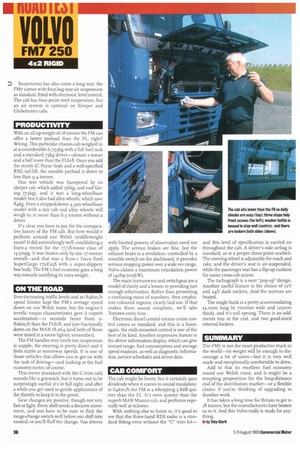VOLVO
Page 38

If you've noticed an error in this article please click here to report it so we can fix it.
FM7 250
4x2 RIGID
D Suspension has also come a long way: the FM7 comes with four-bag rear air suspension as standard, fitted with electronic level control. The cab has four-point steel suspension, but an air system is optional on Sleeper and Globetrotter cabs.
PRODUCTIVITY
With an all-up weight of 18 tonnes the FM can offer a better payload than the FL, right? Wrong. This particular chassis-cab weighed in at a considerable 6,793kg with a full fuel tank and a standard 75kg driver—almost a tonne and a half more than the FL618. Once you add the sturdy AC Payne body and a well-specified RSG tail-lift, the useable payload is down to less than 9.4 tonnes.
Our test vehicle was hampered by its sleeper cab, which added 156kg, and roof fairing (72kg), and it was a long-wheelbase model; but it also had alloy wheels, which save 84kg. Even a stripped-down 4.9m-wheelbase model with a day cab and alloy wheels will weigh in at more than 6.3 tonnes without a driver.
It's clear you have to pay for the comparative luxury of the FM cab. But how would it perform around our Welsh middleweight route? It did astonishingly well, establishing a Furo-a record for the 17/18-tonne class of t3.5tnpg. It was beaten only by one i7-tormer overall—and that was a Euro-1 Iveco Ford SuperCargo r7oE2,3S with a super-slippery box body. The FM's fuel economy goes a long way towards justifying its extra weight.
ON THE ROAD
Ever-increasing traffic levels and an 89km/h speed limiter kept the FM's average speed down on our Welsh route, but the engine's terrific torque characteristics gave it superb acceleration—it seconds faster from o8olcm/h than the FL618, and just fractionally down on the MAN 18.264 (and both of those were tested at a tonne lighter, remember).
The FM handles very nicely too: suspension is supple, the steering is pretty direct and it feels stable at motorway speeds. It is one of those vehicles that allows you to get on with the task of driving—and looking at the fuel economy meter, of course.
This meter (standard with the C-trim cab) sounds like a gimmick, but it turns out to be surprisingly useful: it's in full sight, and after a while you get used to gentle applications of the throttle to keep it in the green.
Gear changes are positive, though not very fast or light. Every shift needs a decisive movement, and you have to be sure to flick the range-change switch well before you shift into neutral, or you'll fluff the change. Van drivers with limited powers of observation need not apply. The service brakes are fine, but the exhaust brake is a revelation: controlled by a sensible switch on the dashboard, it provides serious stopping power over a wide rev range. Volvo claims a maximum retardation power of i4ohp (105kW).
The main instruments and switchgear are a model of clarity and a lesson in providing just enough information. Rather than presenting a confusing mass of numbers, they emphasise coloured regions, clearly laid out. If that makes them sound simplistic, we'll take Toytown every time.
Electronic diesel control means cruise control comes as standard, and this is a boon; again, the stalk-mounted control is one of the best of its kind. Another impressive feature is the driver information display, which can give instant range, fuel consumption and average speed readouts, as well as diagnostic information, service schedules and driver data.
CAB COMFORT
The cab might be heavy, but it certainly pays dividends when it comes to sound insulation: at 64km/h the FM is a whopping 5.8dB quieter than the FL. it's even quieter than the superb MAN M2000 cab, and performs especially well at tickover.
With nothing else to listen to, it's good to see that the three-band RDS radio is a standard fitting even without the "C" trim kit—
and this level of specification is carried on throughout the cab. A driver's-side airbag is standard, as is a proper three-point seatbelt. The steering wheel is adjustable for reach and rake, and the driver's seat is air-suspended, while the passenger seat has a flip-up cushion for easier cross-cab access.
The tachograph is a neat "pop-up" design. Another useful feature is the choice of 12V and 24V dash sockets. And the mirrors are heated.
The single bunk is a pretty accommodating (2.00m long by 7oomm wide and 125mm thick), and it's coil sprung. There is an oddments tray at the end, and two good-sized external lockers.
SUMMARY
The FM7 is not the most productive truck in the world—its weight will be enough to discourage a lot of users—but it is very well made and exceptionally comfortable to drive.
Add to that its excellent fuel economy round our Welsh route, and it might be a tempting proposition for the long-distance end of the distribution market—or a flexible choice if you're thinking of upgrading to drawbar work.
It has taken a long time for Britain to get to 18 tonnes, but the manufacturers have beaten us to it. And this Volvo really is ready for anything.
• by Toby Clark








































































































